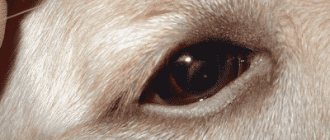Eye diseases and their symptoms
If your hamster's eye is watering, it could be either an infection or an allergic reaction.
It is very easy to distinguish between these diseases:
- Clear discharge from the eyes indicates an allergic reaction, which is most likely caused by the presence of fruit in the diet or the presence of poor-quality sawdust bedding.
- Milky to gray discharge from the eyes is an infection that is transmitted by airborne droplets and can be treated with medication and antibiotics.
In addition, when a hamster's eyes turn sour, this is accompanied by loss of appetite, drowsiness and inactive pastime. This is a signal to start treatment. But an attentive owner should initially make sure that the animal is really sick, and not just that a foreign object got into the hamster’s eye, causing excessive tearing.
The most common diseases that occur in small domestic rodents and cause sour eyes:
- Cold. Accompanied by lethargy, difficulty breathing, sneezing, and often coughing.
- Conjunctivitis. The eyes swell, stick together, the animal is anxious and itches all the time.
- Mechanical damage is associated with increased aggressiveness of the animal or occurs due to careless handling by the owners.
It often happens that when breeding hamsters, they begin to behave aggressively and fight for territory. During a fight, they can seriously damage the opponent's eye socket, after which the eye may leak out. In this case, it is very dangerous to make uninformed decisions, and the animal must be taken to the clinic.
Treatment
If a hamster's eye is festered, it is necessary to urgently show the animal to a veterinarian. It is unacceptable to prescribe treatment on your own; this can not only harm your pet, but also lead to its death. It is especially dangerous to give medications intended for humans to pets. In this case, you can disrupt the functioning of internal organs and simply make a mistake with the dosage, which will be fatal for the small animal. The only thing that is safe to do is to wash the closed eye with Albucid drops and drip it several times a day. If the eye festers, the animal urgently needs to be isolated from other animals and taken to a veterinary clinic as quickly as possible.
It is also dangerous to spread diseases. If you find that your hamster's eye has protruded, this means that the infection is spreading in full swing, and, in addition to treatment, the eye will need to be removed surgically.
By the way, do you know about allergies to hamsters in children? Look, it's interesting!
Hamsters, cute and active pets so beloved by children, also get sick. One of the most vulnerable organs in hamsters is the eyes due to the specificity of their anatomical structure.
Have you noticed that your hamster's eye is stuck together or swollen, it won't open, and you don't know what to do? Your pet needs the help of a veterinarian!
What are the most common causes of eye disease in hamsters?
Inflammation of the mucous membrane of the eyes, or conjunctivitis, is a fairly common occurrence in small rodents, particularly hamsters. Do not think that conjunctivitis is not too dangerous for the animal. This disease can lead to vision loss. It happens that a hamster's eye pops out if he has conjunctivitis. If the disease is neglected, the animal may die.
Most often, conjunctivitis occurs due to pathogenic microflora entering the eye mucosa, which causes damage to the cells of the eye mucosa. This can happen if your pet has been in a dusty place, for example, accidentally crawled under a sofa or into another hard-to-reach place. An animal that has been kept in an unclean cage for a long time can also become ill.
The main symptoms of a disease such as conjunctivitis will be purulent eyes. In this case, the eye may first become inflamed for a short time, and then you notice that your hamster’s eye is stuck together and cannot open due to purulent discharge.
At the same time, both the general condition of the animal and its behavior change: it becomes lethargic, loses activity and refuses food.
The hamster's eyes cannot open: what to do?
So, you noticed that your hamster's eyes do not open, what should you do in this case?
Show the animal to the veterinarian. In this case, it is better to immediately contact a veterinary ophthalmologist. He will be the one who will be able to correctly diagnose your pet and prescribe treatment.
Do not let the disease progress, because in difficult cases your hamster may even require surgical intervention. Seek advice and help from specialists in a timely manner, and your pet will soon become healthy, cheerful and active again.
Do pet hamsters hibernate?
Everyone knows that hamsters are big sleepyheads. But few people know about the seasonal hibernation of domestic rodents. The fact is that this phenomenon does not happen every year, and not with every animal. Therefore, many owners whose homa has survived the winter are very frightened when they once find a motionless body in a cage. They just think the hamster is dead!
If you have a young hamster living with you, and you find him frozen and cold, do not rush to kill yourself and bury the animal! First check: the hamster has died or fallen into a state of temporary torpor. Yes, yes, this happens to these fluffies!
In order to understand whether a hamster has died or is hibernating, you need to know the symptoms of torpor in domestic rodents. To prevent this from happening to your pet, you need to avoid factors that cause numbness at home. Let's talk about all this in detail.
Symptoms of torpor in hamsters
Inexperienced owners may not immediately determine that their dear friend has fallen into torpor. At the same time, the processes in the body of domestic rodents are the same as in wild animals in a state of hibernation. Therefore, sometimes the animals seem dead.
Here are the symptoms indicating numbness:
- the hamster is motionless;
- his body became colder than it was before and seemed to freeze;
- homa does not respond to name and does not respond to touch;
- at the same time, the animal breathes, but weakly and very rarely, its heart works.
This condition in a pet can last from several hours to 1-2 months. The presence of breathing can be determined by holding a mirror to the nose (it will fog up) or by closely observing the pet. The presence of a heartbeat is determined by holding the hamster in your hands.
What causes hibernation at home?
If a homa does not wake up at least once a day, he is considered torpid. This is not a completely normal state for domestic rodents, because there is no pronounced seasonality in apartments. You need to figure out why the hamster sleeps and does not wake up in order to prevent such a situation in the future.
Here are the reasons for numbness:
- The animal is cold. When the temperature in the room drops, domestic hamsters trigger the same instinct as wild ones - they switch the body to economy mode. It is not advisable for the apartment to be cooler than 15 degrees, and if the temperature drops to 10, then numbness is inevitable.
- Darkness. It is harmful to keep pet rodents in the light, but you should also not place the cage in a dark place. Khoma associates darkness with short daylight hours and falls asleep.
- Wrong diet. If there is a lack of food or certain vitamins and minerals, the animal becomes lethargic. In order to consume energy resources more slowly, the body automatically starts an economical mode.
- Stress. Strong shocks can seem to drive the animal into a “coma.” In this state it will be easier for him to recover from the shock he experienced.
By the way, the owner’s untimely desire to play with him can become a big stress for the Homa. If you constantly disturb your hamster while he sleeps, he will become irritable and biting, and then he may even go into hibernation.
But the most common psychological causes of numbness is fear. Swimming, a sharp sound, a sudden attack by a cat, or a fall from a height can frighten a crunchy person to the point of losing consciousness in the literal sense of the word. To keep your pet awake 24 hours a day, protect him from stress, maintain an optimal temperature in the room, and monitor the food and lighting of the cage.
Should I wake you up or not?
If the homa has fallen into hibernation, you have 2 options: wake it up or let the animal sleep. But how do you know which of these decisions is correct? It all depends on the physiological state of the pet.
It is necessary to wake up a baby who is numb from the cold, especially if he is not very well-fed. This will prevent him from dying from starvation and dehydration. But you also need to wake up correctly. A chilled baby needs to be warmed up, and the only sure way to do this is the warmth of the owner’s gentle hands. No heaters! Place the tiny creature in your palms and stroke it gently. Within an hour, you will notice that your body has become warmer and your breathing has become a little faster. Following this, the homa will begin to tremble and stretch a little, which means that he is waking up.
If your pet’s hibernation is a result of severe stress, let him sleep for at least a day. How long do hamsters sleep in this state? It depends on their health and degree of shock.
Symptoms of eye disease
Recognizing the disease is quite easy, since the appearance and behavior of the hamster will change greatly. You should sound the alarm if:
- The animal's eye is very swollen or does not even open.
- The eyelids are wet and sticky.
- A cloudy grayish liquid or a clear liquid is released from the diseased eye (and often both).
The animal itself behaves unusually, it becomes sleepy and lethargic, sleeps more, and moves much less often. Often, pets completely refuse food and water.
Do not confuse conjunctivitis with other causes of fluid discharge from the eyes. Watery eyes can also be a symptom of colds. In this case, the discharge from the eyes is accompanied by wheezing, wheezing during breathing, and the hamster may also begin to sneeze.
Owners of furry animals cannot determine how hamsters see, how good their vision is, or whether the pet requires additional care, which leads to negative consequences. In such a situation, the animal may not take good care of itself and ultimately die.
Symptoms of the disease
Eye diseases in hamsters can be recognized by the following signs:
- the hamster's eye is very swollen and does not open;
- the eyelid area is always wet and sticks together;
- the hamster's eye waters, a purulent fluid of a grayish or yellowish color is constantly secreted, sometimes with blood;
- a stye or lump may appear;
- inflamed areas become red.
These are clear signs that there is inflammation inside the animal’s small body. This is why a hamster's eyes won't open. A sick pet will behave differently - its activity sharply decreases, it becomes inactive, and sleeps most of the time of the day. During this illness, hamsters may completely refuse to feed and drink.
This may be conjunctivitis, the treatment of which is very complex and lengthy. But often the hamster’s organ of vision turns sour and festers due to other diseases, which are much more difficult to cure. For example, if it’s a cold, the hamster’s eye festers, plus he may sneeze, cough, and wheezing appears in his breathing.
How to deal with this scourge? Our tips and recommendations below will help you with this. But first, we will list the main diseases of the organs of vision in the domestic hamster.
The hamster's eyes cannot open: what to do?
To treat your pet, it is best to contact an experienced veterinarian. It is the veterinarian who will be able to correctly assess the situation and select the animal’s medication with the correct dosage. If for some reason the owner does not have the opportunity to contact a professional, he should do the following:
- place the sick animal in a separate container and protect it from contact with other animals;
- all items from the house must be disinfected - for this you can use a weak solution of potassium permanganate, in which the items are soaked for half an hour;
- The animal's eyes should be instilled 3-5 times a day with Albucid drops, which can be found at the pharmacy.
Before instillation, the area around the eye is thoroughly cleaned with a cotton swab moistened with sterile saline solution. As a last resort, you can use boiled water cooled to room temperature. During treatment, your pet must be fed exclusively natural products and not given anything from the list of prohibited treats. The diet must necessarily contain grain crops. Don’t forget about your pet’s body’s need for protein – you should give him a small piece of boiled chicken (without salt and spices) twice a week. If after a few days you have not seen the result and cannot understand why the hamster’s eyes do not open, you need to urgently contact a veterinarian.
In some cases, when the disease has not yet developed significantly, your pet can be helped with water and a small amount of salt. It is worth rinsing the hamster’s vision organs with salted water several times a day to wash out the pus.
Redness
You can wash your eyes yourself
If a hamster has one eye closed, but has not festered, but only turned red, at first you can help him on your own. At home, you can make a weak saline solution from boiled water and wash the inflamed organ with it several times a day. Salt as an antiseptic eliminates any pathogenic microflora formed on the mucous membrane. You can also use chamomile infusion or black tea brew as an antiseptic. You need to wash your hamster's inflamed organs of vision at least three times a day.
If such preventive treatment is useless and you have not opened your pet's eyes, you need to take your pet and show it to a veterinarian.
Why is conjunctivitis dangerous?
Conjunctivitis for hamsters is not at all the same as for humans. If a person can cope with this problem in a few days with the help of eye drops, then your pet does not have the opportunity to overcome the disease on its own. For this reason, you need to be wary if you notice at least one of the signs of conjunctivitis. It is worth considering that conjunctivitis, as a rule, is the very beginning of the pathology. Without taking appropriate measures, conjunctivitis will quickly turn into keratitis, followed by ulceration of the cornea of the eye. If a hamster's eye is swollen, but the owner does not pay any attention to it for a long time, then the rodent may go blind and then die.
The same dangers await the pets of their owners, who not only do not pay attention to the problem, but treat the pet incorrectly.
Under no circumstances should you self-prescribe pills to your pet or, even worse, give injections. This should only be done by an experienced veterinarian.
If you prevent your hamster from getting sick or detect it in time, you won’t have to think about why your hamster’s eye popped out and how to help him in such a situation. Often, due to late detection of the disease, pets completely lose their vision.
Common causes of falling on your back
However, not everything is so scary. When a hamster falls on its back, it may just be playing. The main reasons that can cause an animal to fall are:
- the presence of a sand bath in the cage - in order to independently get rid of the parasites living in the fur, the hamster falls on its back and begins to swing in the sandy mass. This usually causes remorse among breeders;
- a fight with other representatives of the hamster order - in such cases it is worth taking care of the immediate resettlement of the hamsters, since one of the fighters may end badly.
And yet, if the hamster falls on its back, tumbles, runs on the drum, behaves actively, eats well, there is no need to worry, since everything is fine with it. In order to understand what provoked such animal behavior - a desire to have fun or illness, it is enough to observe for some time.
Everyone knows about the short lifespan of hamsters. And then a terrible thing happened: it seems that the pet died. Due to excitement, it is difficult to figure out what to do if the hamster lies and does not move, but is breathing. After all, the presence of breathing means that the animal is still alive.
Before you run to the veterinarian, you need to try to figure out why your pet is lying motionless. Pay attention to other signs: whether the eyes are closed, how often the rodent breathes. If the eyelids are closed and breathing is calm, the hamster may simply be fast asleep.
A hamster's eye does not open - treatment
The hamster's eyes won't open - what should I do? First of all, you need to urgently take him to a veterinary clinic. They will examine him and prescribe treatment. The sooner you see the problem and begin treatment, the greater the chance of success. As a rule, when purulent crusts form, they need to be soaked with a 3% solution of albucid and then removed. Now that we have removed the crust, you can apply hydrocortisone or tetracycline ointment under the eyelids. In order to do everything correctly and not harm the animal, it is better for the veterinarian to do this himself or show him how to do the above correctly. Perhaps in your case he will prescribe other medications, since they are prescribed according to the situation with a particular individual.
Treatment of eye diseases in hamsters
No matter how trivial it may sound, it is better to contact a veterinarian; he can directly determine on the spot the exact cause of eye disease in your hamster and take all necessary measures.
But, suddenly, if you can’t contact a veterinarian, don’t leave the hamster to its fate. You need to help on your own. So, what can we do in the fight against hamster disease:
The first is to assess the situation. If you see that your hamster has purulent discharge from his eyes, you need to remember that this is 99% an infection! Because:
— We isolate the patient from all other animals in the house in case of preventing its spread.
- we clean the hamster’s cage, clean it well, throw away everything, and it is better to disinfect the interior items (at least purely symbolically - soak for half an hour in a solution of potassium permanganate or soda)
— For the patient, we will buy special eye drops “Albucid” at the pharmacy and drop 1-2 drops into each eye 3-4 times a day (4-5 times is possible)
— Diet: only natural products, as in the wild, grains are the basis of normal nutrition for hamsters. You can give a small piece of chicken, the meat has protein.
These simple techniques can save the life of your pet! Let your hamster not get sick, and you don’t get sick!
- < Back
- Forward >
Blepharitis
Often occurs as a result of inflammation of the mucous membrane. Blepharitis manifests itself as inflammation not of the mucous membranes, but of the animal’s eyelids, they turn red and itching appears.
Signs of this disease are the absence of hair around the eyes and the fact that the animal constantly scratches its eyes, as a result of which the hair is combed out. For this disease, the same course of treatment is prescribed as for inflammation of the mucous membranes.
This disease may be a consequence of advanced conjunctivitis. In this case, the inflamed eyelid sticks together, and the inflammatory process spreads deeper and deeper inside. At an advanced stage, both organs of vision may be closed. This disease is accompanied by redness and swelling of the eyelids.
What to do in this case? This disease can be treated if you consult a veterinarian in time. Often the treatment regimen is identical to the treatment regimen for conjunctivitis. Often, special eye drops are used in the treatment of this disease, for example Tsiprovet or Floxal, as well as additionally tetracycline ointment.
With this disease, the hamster should be put on a diet and the cage should be disinfected.
Causes of eye diseases
Hamsters have convex eyes. Because of this, the hamster quite often injures the membrane of the eye and also gets an infection. The most common type of infection is conjunctivitis. An animal can “get” such an infection:
- running through dusty or dirty areas of a room, balcony or loggia, dust gets into the hamster’s eyes, which causes an infection;
- when using low-quality or dirty bedding in an animal’s cage. Do not forget to promptly change the “floor” in the rodent’s home;
- improper nutrition of the animal - you give your pet exotic fruits that cause allergic conjunctivitis;
- the influence of external factors on the health of the animal - the use of especially harmful (aggressive) detergents to wash the cage where your pet lives.
- mutational (dystrophic) changes - disturbances in the functioning of the glands;
- identification of diseases that affect the health of the eyes of animals, such as dental diseases (disease of the incisors), microphthalmia (underdevelopment of the eye) and glaucoma;
- injury to the eye itself - the use of bedding that is not suitable for domestic rodents (coarse sawdust or hay).
All of the above reasons lead to diseases of the animal’s visual organs, and as a result, the hamster’s eyes cannot open, the pet is depressed, sleeps a lot and has an unkempt appearance.
Symptoms of the disease
The most important symptom of diseases of the visual organ of all hamsters is the appearance of cloudy white or grayish discharge from the eye. In this case, the eyelids of rodents are stuck together, wet, half-open, or close the eye completely. Your pet refuses food, and sometimes even water, runs very little, and spends a lot of time sleeping. Knowing that furry rodents often carry infections into the eyes, their owners are haunted by questions related to the eye health of their charges:
Why doesn't my animal's eyes open? The reason for this may be an ordinary draft. Have you decided to ventilate your apartment without protecting your pet from cold air and dampness? So you end up with a problem with your pet’s eyes. Hamsters have a hard time withstanding dampness and wind. The second most common cause is eye injury; if the injury is accompanied by active scratching of the rodent's organ of vision, then most likely your pet has unilateral conjunctivitis.
Let's highlight the main reasons why a hamster does not open its eyes:
- allergic reaction to both food products and surrounding objects (litter, dust, tree bark, tree branches);
- acute conjunctivitis;
- some serious internal disease of the animal;
- advanced age of the hamster.
What to do if a rodent's eye turns sour or festeres.
Suppuration of the eyes in hamsters occurs due to the fact that microorganisms enter the mucous membrane, causing all kinds of pathologies (diseases) of the eye.
With an infectious disease - conjunctivitis, the animal's eyelids stick together, the animal opens its eyes with difficulty, and often rubs its muzzle with its paws. The hamster eats without appetite, and sometimes even refuses to eat, spends a lot of time sleeping, and tries to hide from the light.
Sometimes there are cases: violations of asymmetry on the muzzle or protrusion of the eyeball outward; if the eye is injured, it can simply fall out. Eye loss is called eyeball prolapse. This disease occurs with suppuration, and if not treated in a timely manner, the animal can not only lose its visual organ, but also die.
Eye pseudo-diseases
Monitor your hamster's immunity
Often the cause of eye inflammation in a domestic hamster can be another disease. This phenomenon is possible if the rodent’s cheek pouches become inflamed. As a result, the animal's eye hurts, waters, and the lower eyelid swells. After some time, the eye can be observed to stick together and increase in size.
In such a situation, you need to do the following - seek help from a veterinarian. There is such a procedure as cleaning the cheeks. It will not only ease your pet’s suffering, but also relieve such consequences as redness, swelling, inflammation and suppuration of the eyes.
Treatment of eye diseases
Hamsters may not be able to open their eyes due to an allergy to dust in the room or litter. In such cases, it is necessary to get rid of dust in the apartment and replace the bedding in the rodent’s cage with corn - hypoallergenic. If your pet has any discharge from the eyes, it must be removed with a cotton swab soaked in saline solution, chamomile infusion, or simply warm boiled water. Apply drops at least 3 times a day (0.25% solution of chloramphenicol).
To treat inflammatory processes yourself at home, it is best to drip Albucid into both eyes of the animal 3 times a day.
If your hamster does not open its eyes, you should immediately show the animal to a specialized veterinarian. At the clinic, the doctor will conduct all the necessary preliminary tests and examinations of the rodent, and find out the reasons that led to the disease itself. Having determined the nature and severity of the disease, your furry friend will be prescribed treatment. Ophthalmotherapy tactics include:
- elimination of all infections;
- pain relief;
- saving the eye if possible;
- identification and then treatment of primary diseases of fluffy animals, such as glaucoma or dental diseases (incisors);
- Serious eye diseases will require immediate surgical treatment - surgery.
We tried to give the most detailed answer to the topic “why a hamster’s eyes don’t open,” giving reasons and recommended treatment. But always remember, by self-medicating you are putting your pet’s life in danger. The best option would be to contact a specialist who will quickly identify the cause of the disease and prescribe the correct treatment.
I would like to remind owners of four-legged furry rodents that competent and timely assistance will not only help your pet recover, but in some cases will save his life.
Due to their natural characteristics, eye diseases are very common in hamsters. The owner must be able to provide first aid to the pet and know what to do if the hamster’s eye does not open.
The eyes of night rodents are large and convex, which gives them a charming appearance and allows them to notice a predator in time. But physiological exophthalmos (bulging eyes) significantly reduces the protection of the organ of vision. The hamster can easily injure it or prick itself due to a delayed blink reaction. The central zone of the cornea is poorly washed by tears and is little wetted, so even a minor injury can lead to an ulcer. Hamsters are active at night and are not adapted to bright light. A bright flash or direct sunlight can damage hamsters' already weak vision.
Due to the pet’s small size and independent nature, the owner often discovers the problem in an advanced stage: the hamster has one eye closed, or both eyelids are glued together with pus, one is larger than the other, and so on.
Why do they hibernate?
A hamster sleeping for long periods of time is not a good thing.
If an animal sleeps all day and night for several days, then this is torpor. For rodents living at home, this is not a normal process, because there are no seasonal changes in the premises. Therefore, it is worth finding out why the hamster constantly sleeps and does not run at night.
Causes of numbness at home:
- The air temperature is too low. When the temperature in the house drops sharply, animals trigger the same instinct as their wild relatives. Therefore, it is better that the air temperature is not less than 15 degrees. Otherwise, numbness will set in instantly.
- The room is constantly dark. It is not recommended to keep rodents in the sun, but darkness also has a negative effect on them. Homa associates constant darkness with shortening daylight hours.
- Poor nutrition. Lack of vitamins and minerals in a hamster's diet can also lead to torpor. Therefore, in order not to bring the animal to such a situation, it is worth feeding it correctly. Give not only grain, but also fruits and vegetables.
- Stressful situations. Severe stress can put an animal into a coma. He will constantly sleep, which will allow him to survive such a shock.
More often, stress for such animals comes from the breeder’s untimely desire to play with him. You should not touch him when he is sleeping or eating. Such irritation can drive him to stupor.
But this is not the main cause of stress. Most often it becomes fear. At the same time, the homa literally loses consciousness. Therefore, in order for your animal to lead a normal life, it must eat properly, not be stressed and be in a normally lit room.
Symptoms
People who encounter this phenomenon for the first time cannot immediately identify numbness. In a state of sleep, hamsters breathe slowly and their heart rate decreases. The rodent's entire body goes into a kind of economy mode. Body temperature during this period is within normal limits. Sometimes the pet may get up to eat. With the arrival of spring they wake up.
Main symptoms of numbness:
- the animal does not move;
- body temperature drops;
- the pet does not respond to its name;
- the animal breathes, but very weakly.
A pet can sleep in this state for 2 months. To check whether a Homa is breathing or not, just hold a mirror to his nose. If it fogs up, it means the rodent is simply numb.
Non-inflammatory diseases
Cataract
If your hamster's eye is cloudy, it could be a cataract - a metabolic disorder in the lens. The disease leads to blindness. Eye drops are not effective, and surgery is not performed in either the Djungarian or the larger Syrian hamster. When the owner notices that the hamster's eye has turned white, this is a reason to consult a doctor, despite the fact that there is no treatment. Cataracts in a hamster are a sign of old age, decrepitude of the body, and in a dwarf or Campbell's hamster it is an indirect sign of diabetes. In both cases, treatment of the underlying disease is required to prolong the pet's life.
A thorn on the surface of the cornea is not a cataract, but the consequences of an injury, a scar. With cataracts, something light is visible in the depths, in the area of the pupil.
Glaucoma
An increase in intraocular pressure is accompanied not only by enlargement and bulging of the eyeballs, but also by severe pain. A doctor makes a diagnosis of glaucoma after measuring the pressure in the eye. It is not possible to normalize it with drops; the only treatment is enucleation to stop the pain. If you don't do anything, the eye will eventually burst. It is difficult to say why such a pathology occurs. Since Campbell's hamsters are most often affected, rarely Djungarians and never Syrians, a genetic (hereditary) nature is assumed.
Oncology
A small bump on a hamster's eyelid may be a tumor. Oncology can also be the reason why one eye suddenly becomes larger than the other. Ornamental rodents are susceptible to cancer and there is no effective treatment in such cases.
Even if you know thoroughly how to treat a hamster whose eye is inflamed, do not neglect a visit to a specialist. In addition to wounds and infection, other problems must be ruled out. A ratologist will help you understand why a hamster’s eye does not open: perhaps the eye itself is fine, but the cheek pouch is inflamed or there is a problem with the teeth (“flux”). Self-medication is also unacceptable if the general condition worsens: if the animal is lethargic, its eyes are closed, and there is also discharge from the nose, the hamster probably has the “flu”, a respiratory infection.
Other diseases
If your hamster is breathing frequently "out of the blue" without being scared or tired, this indicates respiratory or heart failure.
You need to listen to the breathing of a tiny animal - wheezing, gurgling, snuffling indicate problems with the lungs. If you've recently had a runny nose and your hamster has become lethargic and reluctant to eat, it could be pneumonia (pneumonia). The animal simply cannot breathe, so it tries not to move and freezes in one place.
Treatment consists of antibiotic therapy - for small rodents, Baytril 2.5% is traditionally used at a dose of 0.4 ml per 1 kg of weight (for a dzhungarik weighing 50 grams, this is 0.01 ml). Injections are given subcutaneously 1 time a day for 10-14 days.
If a hamster lies motionless with his eyes open and breathes heavily, and before that he was sick for several days, then he dies. There is no way to help a rodent in agony; even an experienced veterinarian can only end the suffering by euthanizing the animal.
Consider whether your hamster has wet tail fur (a sign of diarrhea), a sudden increase in abdominal contour, or sudden weight loss. Hamsters have a very fast metabolism, so they cannot be sick for a long time: without proper treatment or in case of severe problems, they “burn out” in a few days.
Decorative hamsters have fragile health, and yet the animal can live its entire short life without getting sick. To do this, you just need to follow simple feeding and maintenance rules. In case of unforeseen circumstances, you need to find out in advance where to go for an appointment with a rodent - general practitioners will not be able to provide qualified assistance. And do not despair if the hamster lies and does not move, but breathes: perhaps all is not lost.
The hamster lies motionless: reasons 4.8 (95%) 12 votes
The hamster's eyes won't open - what should I do?
When you decide to get a hamster, you must understand that it needs care. It consists not only of proper nutrition, walking and cleaning the cage, but also of caring for the health of the hamster. Namely, all the actions described above lead to a change in health status. But you can’t keep track of everything, and even with good care, it happens that the animal gets sick. The eyes are often affected. What happens is that the hamster’s eye does not open, the eye is stuck together or it festers. What to do in this case?
Everything starts small. It can’t be that everything was fine an hour ago, but now the eye is already festering and won’t open. Perhaps you didn’t notice in time when it all started. And the sooner you start treatment, the easier it will be, and the faster the result. These rodents are very active, in nature they dig the ground, so it is quite possible that he will dig the litter in the cage. This can hurt the eyeball, cause an infection and contract conjunctivitis. But this is not the worst thing; if a hamster’s eye pops out, then this is more serious.
Conjunctivitis is an inflammation of the mucous membrane of the eye. The cause is most likely an infection, physical or chemical irritation. Often accompanied by itching. When a hamster scratches a sore spot with its paws, it only gets worse, as this contributes to its spread. At first, the eyes may simply water, then pus appears, at this stage the hamster’s eyes may not open. If left untreated, the disease can lead to complete loss of vision and even loss of the eyeball.
Hamster won't open his eyes
Conjunctivitis
This disease affects not only people, but also animals - the hamster is no exception. Moreover, the treatment of such a disease is quite difficult for domestic hamsters. In some cases, if timely measures are not taken, the animal may simply die.
Conjunctivitis is the initial stage of one of the most serious pathologies in an animal. If a hamster's eye festers and does not open, perhaps some kind of infection or virus has settled inside its body. At an advanced stage, conjunctivitis can cause the development of keratitis, and then it is not far from such a pathology as protrusion of the cornea. What to do in such a situation so as not to trigger the disease?
Therefore, if a hamster’s eye is swollen, very swollen, and its owner does not pay attention to his pet, first the rodent may go blind, then die completely.
The same outcome awaits those pet rodent lovers who do not approach the treatment of their animals competently. Remember that any treatment prescribed independently can result in disastrous consequences for your own household.
With a timely response to an animal's illness, you will never have a question about why the hamster's eye popped out or why it was completely closed and festered.










